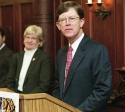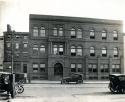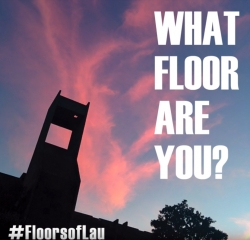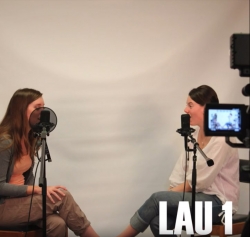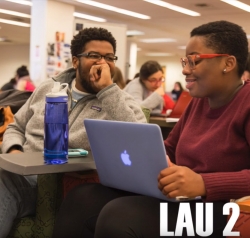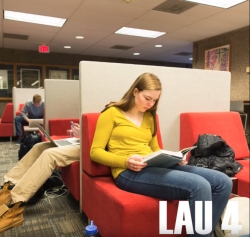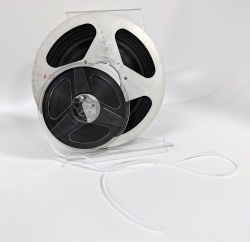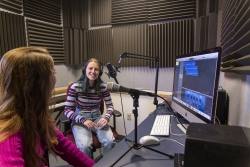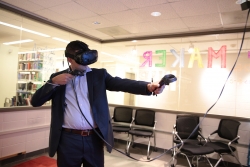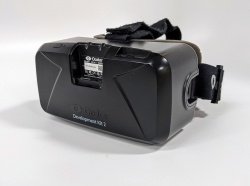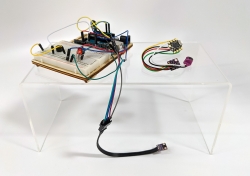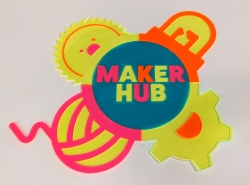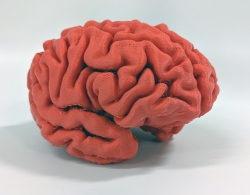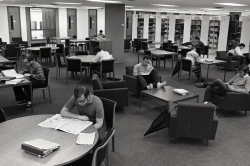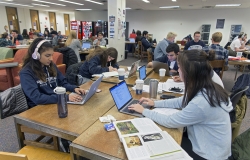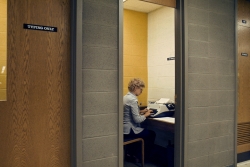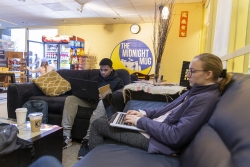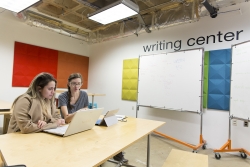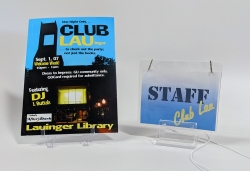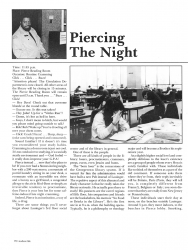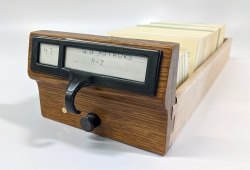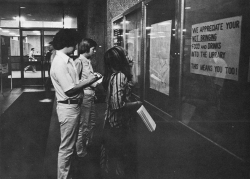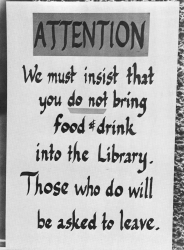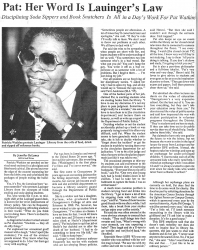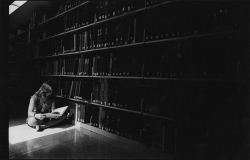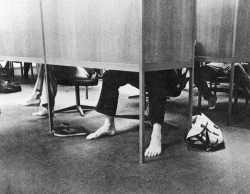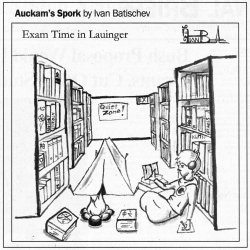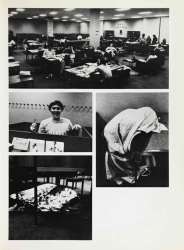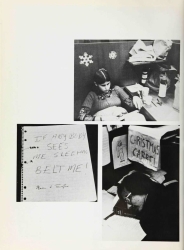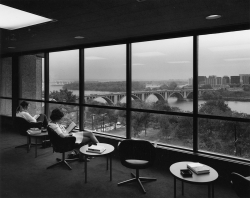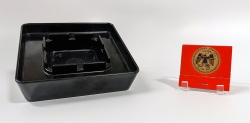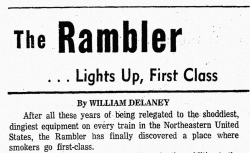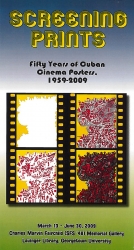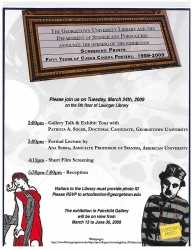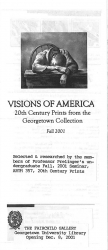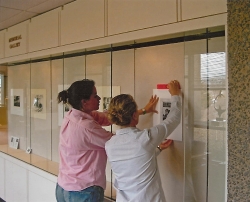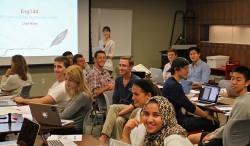This exhibition traces the history, work, and evolution of Lauinger Library from its planning and opening in 1970 through the present day.
For five decades, the Library has provided services, collections, and spaces which Hoyas rely on to extend and deepen their curiosity and learning. A cadre of dedicated staff and generous donors have ensured that despite the seismic changes in information technology and publishing, students and faculty have the resources they need to create substantive, new scholarship.
The Library of today remains a central place to conduct research and to study; it is also a place of creativity and exploration. Several major transformations in the Library’s recent history reflect a shift toward more collaborative and experiential learning. Newer spaces like the Gelardin New Media Center, the Maker Hub, and the Booth Family Center for Special Collections provide opportunities for students and faculty to engage with the topics they are studying in innovative ways, whether they are consulting primary sources or finding new technologies that will allow them to tell the story of their research.
We may not be able to predict most of what the next 50 years will bring, but we do predict that Lau will be part of that future!
Planning and Construction of Lauinger Library
Portion of Library Door, 1831 (Georgetown University Art Collection)
Georgetown College’s first library was housed in the President’s room in Old South (no longer standing). After the library moved to Old North in 1831, College art instructor James Simpson (1805-1880) decorated its door with a trompe l’oeil depiction of shelves of imaginary books by Georgetown faculty of the time.
Riggs Library in Healy Hall, pictured around 1910
From 1891 to 1970, the University Library was housed in Riggs and its various annexes. A rare example of Victorian, cast-iron prefabrication, Riggs Library is 40 feet wide by 60 feet long. When the Library opened, it housed around 50,000 books.
Rules for student use of Riggs Library, ca. 1893
When Riggs Library opened in 1891, seniors (allowed in on Wednesdays and Saturdays only) could not check out books or enter the alcoves to browse. Graduate students, who were at least allowed every day, were subject to the same restrictions. Underclassmen were barred from the Library entirely and had to request books through their professors.
Map of the Georgetown University campus showing potential sites for a new library, 1945
Riggs Library quickly outgrew available space in Healy Hall and plans were formulated for a new library building as early as the 1930s. A number of sites were considered including those on which Reiss Science and Village C were later built. By 1965, the choice had narrowed to the two possibilities on 37th Street. However, changes to the District of Columbia's zoning laws removed the site opposite the main gates from consideration, leaving the library to be situated on the corner of 37th and Prospect Streets.
Sketch of proposed new library, 1954
While ideas about the optimal size and capacity of a new library remained relatively fixed through the 1950s and 1960s, the same was not true of its architectural style. This 1954 rendering did not even hint at the brutalist design to come.
“Library Architect Named.” Georgetown Record, July 1965
The architectural firm of John Carl Warnecke and Associates was commissioned to design the new library in 1965. Warnecke, known for his design of the gravesite of John F. Kennedy in Arlington National Cemetery, was chosen because of "his understanding of the needs of the University and the neighborhood, and his ability to harmonize modern design with traditional settings."
New Main Library for Georgetown University by John Carl Warnecke and Associates, Original Concept, 1966
". . . The most important exterior aspect of the library is its relationship to the older buildings on campus, especially the Healey [sic] building, which will be its nearest neighbor. Stylistically, the Healey building, is “Flemish Romanesque” while Copley and White-Gravenor are built in a style commonly known as “Collegiate Gothic” . . . The most significant common denominator in all these buildings is the undulating exterior wall surface and the profusion of vertical elements . . . We recognize these aspects in the design of the Library building, which will have an irregular outline and a pronounced vertical emphasis . . ."
Architectural drawings by John Carl Warnecke and Associates
Interior design plans for Library offices and soft furnishings by Rita D. Schaefer
Rita D. Schaefer also worked on the interiors of the Colgate University Chapel and the National Girl Scouts Building. She died in September 1970, only five months after Lauinger Library opened.
Announcement by President Robert J. Henle, S.J. of the naming of the Library for Joseph Mark Lauinger, March 11, 1970
Joseph Mark Lauinger, a 1967 alumnus and Army first lieutenant from Tulsa, Oklahoma, was killed while commanding a reconnaissance mission in Vietnam on January 8, 1970. Lieutenant Lauinger was posthumously awarded the Silver Star for gallantry in action, the Bronze Star Medal, and the Purple Heart. These medals are on permanent display in the lobby of the Library.
Members of the Lauinger Family and University administrators at the Library’s cornerstone ceremony, October 24, 1970
Moving in, March 1970
The move of the main book and periodical collection from Riggs into Lauinger began on March 26, 1970; Lauinger was fully operational by the time students returned from Easter break on April 6. Volunteers from Alpha Phi Omega and the Collegiate Club supplemented the work of an outside moving company.
Award of Merit in recognition of distinguished accomplishment in library architecture from the American Institute of Architects, 1976
While both positive and less positive opinions about the external appearance of Lauinger Library have been expressed in the years since the building’s opening, press critiques of the building when it opened were generally favorable. The Evening Star described it as "adding an imposing new shape to the Potomac Palisades setting" and The Washington Post commented that the "architects managed to blend it into the cityscape, if not unobtrusively, [then] successfully." The Library's design was recognized by the American Institute of Architects in 1976.
Library construction photos, 1967 to 1969
After prolonged discussions over the proposed site (both the Zoning Committee of the National Capital Planning Commission and the Commission of Fine Arts initially recommended that the new library be built somewhere other than the 37th and Prospect site) and the design (especially the height of the Library’s penthouse and the parapet around the penthouse), ground was broken on June 10, 1967 for the first stand-alone library building in Georgetown’s then 179-year history.
The Evolving Library
Ad in The Hoya, September 7, 1973. Photograph of the University Bookstore, 1975
In July 1973, the bookstore moved from White-Gravenor to the basement of the Library where it remained until the opening of the Leavey Center in 1988.
Halle, Johann Samuel. Fortgesetzte magie, oder, Die zauberkräfte der nature, so auf den nutzen und die belustigung angewandt worden. Wien: Trattnern, 1790. Print. (Woodstock Theological Library) / Program from Dedication of Woodstock Theological Center
The Woodstock Theological Library, one of the oldest and most notable collections of Catholic theological resources in the U.S., came to Georgetown in 1974. Originally the library for Woodstock College (1869-1974), a Jesuit seminary, the collection was gradually formed from smaller collections of books and manuscripts that belonged to some of the earliest houses of Jesuit formation in America. Woodstock houses an incredible trove of rare books and archives which reflect and embody four-hundred years of Jesuit existence.
Regulations concerning the observance of Holydays in Maryland (Archives of the Maryland Province Society of Jesus)
Just as Maryland Jesuits accommodated their mission-building to political realities, they also modified fundamental religious practices to ensure the success of the emerging tobacco economy. In 1722 Maryland Jesuits proposed rules to ecclesiastical authorities in London that exempted the mission from the requirement that Catholics refrain from manual labor on Sundays and other holy days. After its approval by the Vicar Apostolic, these rules applied mostly to enslaved laborers.
The Booth Family Center for Special Collections has served as the repository of the Archives of the Maryland Province of the Society of Jesus since 1977, when the Province placed it on deposit at Georgetown University. Students, faculty, and scholars have studied these records to understand the origins of Catholicism in the United States and the ownership of enslaved people by the Province, particularly its decision to sell 272 of them in 1838.
Georgetown University Library (instructions for locating and borrowing books), fall 1971 / Lauinger Library reference area. Pictured in Ye Domesday Booke, 1989
The 1980s brought increasing utilization of computers to provide electronic searching and with that, the realization that growing reliance on such resources required proactive reconfiguration of Library spaces and infrastructure.
For a time, the card catalog and the online catalog (unveiled in 1985 and known as GEORGE) coexisted but no new cards were added to the card catalog after May 1987.
Renovation Poster, 1993 / I Survived the Renovation T-Shirt designed by Library graphic artist and photographer David Hagen, 1993. Gift of Joseph E. Jeffs
The early 1990s saw a number of renovation projects, beginning with work on the lower level and the 5th floor in 1991. The third floor was renovated in 1993, with much of the work concentrated over the summer months to limit disruption to library users. This renovation saw the removal of the card catalog and the creation of the Forsgren Reference Area, named for and funded by John Forsgren, C’1967.
Kerbs Exhibit Area photographed in 2019 (on display, The Lost Museum of Georgetown University curated by Gretchen Henderson)/Stephen R. Kerbs, B’1967, pictured in the Protocol / “Remaking Connection” by Tony Kerbs, C’1973, Georgetown Magazine, fall 1998
In 1998, a display case located on the 3rd floor between the Reference and Access Services desks was dedicated to the memory of Stephen R. Kerbs, B’1976. The Kerbs Exhibit Area, along with the donor recognition wall in the lobby, was funded by the Stephen Richard Kerbs, B'67 Library Endowment Fund created in 1998 by family and friends of Mr. Kerbs. Income from the fund allows the library to mount ongoing exhibitions.
Pair-cased verge pocket watch belonging to John Carroll. 18th-century Continental silver (University Art Collection, 1111.298.1)
Oversight of the University Art Collection was transferred from the Provost's Office to Lauinger Library in December 1999 with the retirement of Curator Cliff Chieffo, who also taught for over 30 years in the Art Department. It was a natural fit for art to join the other special collections under the Library's purview, providing wonderful primary source material for teaching. Some of the artworks relate to sibling collections in other units. This fine, decorated pocket watch belonged to Georgetown’s founder, John Carroll. It has several markings inside including some numbering which may refer to the year of its creation.
Program from the Gelardin New Media Center ribbon-cutting ceremony, March 22, 2002 / Gelardin New Media Center brochures, ca. 2007 and 2010
In the 2000s, new areas including the Gelardin New Media Center and the Millennium News Room were created in the Library to facilitate access to new technologies and computing resources. The opening of the Gelardin New Media Center greatly expanded access to digital media equipment, software, and services as students and faculty transitioned from being mostly consumers of media to being producers of all forms of digital content and scholarship.
LiveHelp. Screenshot from the Library’s homepage, December 8, 2002
The LiveHelp service, launched in November 2002, was billed as "interactive real-time chat technology to reach out to patrons wherever they are - not only when they are in the library, or near a telephone." LiveHelp hours initially were 2 pm-8:30 pm, Monday-Thursday, and 2 pm-4 pm on Friday.
Special Collections, pictured in 1975 / Swatch of the original Special Collections reading room carpet, cut just prior to the 2014-2015 renovations / Booth Family Center for Special Collections ribbon-cutting ceremony, June 1, 2015
2014-2015 saw a total renovation of what was then known as the Special Collections Research Center. This work was funded by gifts from Suzanne Deal Booth and David G. Booth, Barbara Ellis Jones C’1974, the Lauinger family, and numerous other Library supporters. The renovation created a state-of-the-art, environmentally controlled storage area, a classroom dedicated to teaching with special collections material, an enhanced reading room named for Georgetown Professor Emeritus and Library Board member Paul F. Betz, and improved exhibition space. In the words of University Librarian Artemis G. Kirk, this positioned the renamed Booth Family Center for Special Collections "not only to protect and preserve rare treasures but also to make them readily available for our scholars and students to conduct their primary source research - for generations to come."
Midnight Mug chalk price board, ca. 2005 / Midnight Mug Office Hours Program spring 2020, email sent January 9, 2020
Midnight Mug and Pete and Ann’s Place, established through the generosity of Peter C’1960 and Ann Tanous in collaboration with The Students of Georgetown, Inc. (The Corp), opened on the second floor of Lauinger in January 2003. A few years previously, the idea of a library coffee shop housed in the Pierce Reading Room had been discussed but not pursued.
In addition to serving coffee and snacks, the space creates opportunities for scholarly conversations between faculty and students, thanks to its office hours program.
DigitalGeorgetown as of 10/7/2007 / Cover of Hacia Una Vida Mejor, a comic book from Alliance for Progress Cartoon Book Program records (Ernest A. Keller Papers, Box 4, Booth Family Center for Special Collections)
DigitalGeorgetown was unveiled in the fall of 2004 as the online portal for Georgetown University’s institutional repository and digital collections. With over 200,000 visitors each month and over 500,000 digital objects, DigitalGeorgetown provides access to streaming media, electronic theses and dissertations, and image collections highlighting a wide variety of scholarly and archival materials. From student publications such as The Hoya and Utraque Unum to rare manuscripts and incunabula, these collections are expanding every month.
Hacia una Vida Mejor can be viewed in DigitalGeorgetown.
“Maker Hub Launch Lights Up Lauinger.” The Hoya, October 18, 2016 / Maker Hub flyer, December 2019
Inaugurated in October 2016, the MakerHub routinely works with Georgetown Faculty, helping them enhance their curriculum through Maker activities, tours, lectures, and guided conversations on the impact of Makers and Maker Culture on their field of study. It also serves as a collaborative space for Georgetown community members to make things using technology and as a central location for tech and creative groups.
“New Electronic Information Resource Center Under Construction.” Faculty / Library Newsletter, March 1994
Milestone Acquisitions and Building for the Future
John Milton, Paradise Lost: a poem in ten books. London: Printed by S. Simmons, and are to be sold by T. Helder at the Angel in Little Brittain, 1669.
Lauinger Library acquired the one millionth volume, a first edition of Paradise Lost, in 1983 through the generosity of some 170 members of the Library Associates and other friends of the Library. Milton’s seminal work was selected out of a list of 25 titles by a special committee made up of members of the Library Associates, whose goal was to select a title that would be recognized universally as a landmark book of the western world and that would have relevance to Georgetown’s academic programs. The volume was unveiled at a ceremony on November 20, 1983.
Booth Family Center for Special Collections
General LC PR3560 1669
Program and Photograph from the presentation of the one millionth volume, November 20, 1983
Pictured here are (L-R) University Librarian Joe Jeffs, the Honorable John W. Snyder, Chairman of the Library Associates Board of Trustees, Georgetown University President Timothy S. Healy, S.J., and Rector of the Jesuit Community James A. Devereux, S.J.
You can read more about this milestone acquisition, including text of Fr. Healy's speech, by clicking here.
Washington, George, 1732-1799 [Thanksgiving Broadside] By the President of the United States of America. A Proclamation [New York: Childs and Swain (?), 1789]
George Washington’s Thanksgiving Day proclamation, a gift from Dr. Marshall B. Coyne (LHD ‘90), was presented as Lauinger Library’s official two millionth volume at a ceremony on May 4, 1994. The broadside, one of only seven recorded copies and printed in the same year as Georgetown’s founding, proclaims the first national day of Thanksgiving ever celebrated in the United States of America. To honor the acquisition, the Library held an event which was headlined by Mario Vargas Llosa, Distinguished Writer in Residence at the School of Languages and Linguistics, who spoke on “The Paradise of Books.”
Booth Family Center for Special Collections
Gift of Marshall B. Coyne (LHD ‘90)
Program and Photographs from the presentation of the two millionth volume, May 4, 1994
(L) Georgetown University President Leo J. O’Donovan shakes hands with Marshall B. Coyne, member of the University Board of Directors and donor of the two millionth volume, as University Librarian Susan K. Martin looks on.
(R) Mario Vargas Llosa, Distinguished Writer in Residence at the School of Languages and Linguistics, delivers his address on “The Paradise of Books.”
Made at Lauinger Library
Loving Justice: Legal Emotions in William Blackstone's England
Kathryn D. Temple (Georgetown University Professor, Department of English)
New York : New York University Press, 2019
Book acknowledgment reads: . . . My heartfelt thanks are owed to our highly tolerant and supportive Georgetown Library professionals, especially Jeffrey Popovich, Sandy Hussey, and Jill Hollingsworth. I hope I don't hold the faculty record for most fines expunged, but it's possible . . .
Avery Cardinal Dulles, SJ: A Model Theologian, 1918-2008
Patrick W. Carey (Marquette University Emeritus Professor of Theology)
New York : Paulist Press, 2010
Book acknowledgment reads: . . . Leon Hooper, SJ, director of the Woodstock Center [Library] at Georgetown University, gave me access to Dulles' personal papers relating to his experiences at Woodstock College, and Lynn Conway and Scott S. Taylor, archivists at Georgetown, provided comfortable working conditions for my examination of those papers . . .
Blacking Up the Ivory Tower: Blackface Minstrelsy in College Life at Georgetown (Honors Thesis Submitted to the Department of History, Georgetown University)
Marcus Lustig C’2019
Acknowledgment reads: . . . I owe even more to university archivists Lynn Conway and Ann Galloway whose enthusiasm for the project nearly exceeded my own. Practically speaking, this thesis is only possible because of their counsel and patience . . .
Program from Georgetown University Minstrels and Comedy for Benefit of Poughkeepsie Crew Fund: Belasco Theatre, May 7, 1910 (Georgetown University Archives)
NATO 1948: The Birth of the Transatlantic Alliance
Lawrence S. Kaplan (Georgetown University Professorial Lecturer in History)
Lanham, Md. : Rowman and Littlefield, 2007
Book acknowledgment reads: . . . I have benefited from the special attention Georgetown University Librarians Kristina Bobe, Timothy Cash, and Rachel Donelson have given me in the microform room of the Lauinger Library . . .
The Secret History of Jane Eyre: How Charlotte Brontë Wrote Her Masterpiece
John Pfordresher (Georgetown University Professor, Department of English)
New York : W.W. Norton & Company, 2017
Book acknowledgment reads: . . . and from the Lauinger Library Melissa Jones [Literature Liaison and Reference Librarian] and Meg Oakley [Director, Copyright & Scholarly Communication] offered invaluable insight and assistance . . .
John Dooley's Civil War: An Irish American's Journey in the First Virginia Infantry Regiment
Robert Emmett Curran (Georgetown University Professor Emeritus, Department of History)
Knoxville : University of Tennessee Press, 2012
Book acknowledgment reads: . . . I am grateful to Lynn Conway, Georgetown University Archivist. Of the many contributions she made to the making of this edition of Dooley’s writings, none was more important than her discovery of the auction of Dooley’s diary in 1997 and her subsequent suggestion that I contact the Maymont Foundation, the body that manages James Dooley’s former estate in Richmond, as a likely source of information about the whereabouts of the diary. Ted Jackson, of the Special Collections Division of Lauinger Library at Georgetown, meticulously photographed the six hundred plus pages of Dooley’s notes and other writings so that I could transcribe them at leisure in my Kentucky workplace . . .
Booth Family Center for Special Collections General LC E581.5 1st .D67 2012
John Dooley of Richmond. Undated carte de visite by J. Goldin, Washington, D.C. (Georgetown University Archives)
War Diary of John E. Dooley: “Reminiscences of (Pickett’s Division) Lee’s Army, from October 1862 to June 1863.” (John E. Dooley S.J. Papers, box 1, folder 2, Booth Family Center for Special Collections)
Claudius Caesar : Image and Power in the Early Roman Empire
Josiah W. Osgood (Georgetown University Professor, Department of Classics)
Cambridge ; New York : Cambridge University Press, 2011
Book acknowledgment reads: . . . I also express my gratitude to the staff of Lauinger Library at Georgetown for their unfailing help, and salute University Librarian Artemis Kirk for her heroic efforts on the Library’s behalf . . .
Boundaries of Faith : The Development and Transmission of Medieval Spirituality
John C. Hirsh (Georgetown University Professor, Department of English)
Leiden ; New York : E.J. Brill, 1996
Book acknowledgment reads: . . . I am grateful to the staff of Georgetown's Lauinger Library, and in particular to the Woodstock Collection, for much help over the years . . .
The Poor Belong to Us: Catholic Charities and American Welfare
Dorothy M. Brown (Georgetown University Emeritus Faculty, Department of History) and Elizabeth McKeown (Georgetown University Emeritus Faculty, Department of Theology and Religious Studies)
Cambridge, Mass. : Harvard University Press, 1997
Book acknowledgment reads:. . . Marty Barringer of Special Collections and Jon Reynolds and his staff at the Georgetown University archives introduced us to the important Tierney-America collection, and Kathleen Lyons and the staff of interlibrary loan services at Georgetown’s Lauinger Library have been unfailingly helpful . . .
Conditions Governing Payments to Charitable Institutions. Budget for 1916 As Adopted by the Board of Estimate and Apportionment [The City of New York]
Richard Tierney Papers, Box 1, Booth Family Center for Special Collections
Appendix to address of Herman A. Metz Before The Committee on Taxation Constitutional Convention. Associates of Private Charities, Inc. 52, Chambers Street, New York, 1915
Richard Tierney Papers, Box 1, Booth Family Center for Special Collections
Ruin of the Roman Empire
James J O'Donnell (Georgetown University Provost, 2002-11)
New York : Ecco, 2008
Book acknowledgment reads: . . . My gratitude to Artemis Kirk, Georgetown University Librarian, and to her splendid staff is equally immense . . .
Provost James O'Donnell, pictured on March 12, 2002 with former Provost Dorothy Brown seen to his right (Georgetown University Archives)
The First 125 Years: 1870-1995: An Illustrated History of the Georgetown University Law Center
Daniel R. Ernst (Georgetown University Professor of Law)
Georgetown University Law Center, 1995
Digital Georgetown http://hdl.handle.net/10822/1043490
Book acknowledgment reads: . . . Jon Reynolds, the Archivist of Georgetown University, and his staff, aided research into collections under his jurisdiction . . . with unfailing efficiency, intelligence and good humor. Dave Hagen and Evan Sheppard rendered much appreciated photographic services . . .
Travels of a T-Shirt in the Global Economy: An Economist Examines the Markets, Power and Politics of World Trade
Pietra Rivoli (Georgetown University Professor, McDonough School of Business)
Hoboken, N.J. : John Wiley and Sons, 2005
Book acknowledgment reads: . . . Thanks, too, to Jennifer Boettcher of the Lauinger Library at Georgetown . . .
Invitation to Library Associates event: Travels of a T-Shirt in the Global Economy with Pietra Rivoli, McShain Lounge, June 1, 2005 (Georgetown University Archives)
Morbid Disconnect: The Battle Over Slave Health in the Early American Tobacco Industry (Honors Thesis Submitted to the Department of History, Georgetown University)
Andrew Meshnick C’2017
Acknowledgment reads: . . . I received invaluable help from across the Georgetown Library System. Specifically, Maura Seale, the American History reference librarian at Lauinger Library, helped me locate countless items in obscure history books. Since my first consultation in the fall of my freshman year on my Gandhi paper, Maura has been a tremendous resource throughout the research process. Once I identified items for my research, Dana Aronowitz and the Lauinger Library Interlibrary Loan team contacted libraries across the country to bring those items to Georgetown. I was often amazed to find items from far away states like Utah or Tennessee. The Bioethics Research Library was immensely helpful, both for helping navigate scientific literature and for employing me throughout the thesis writing process. The Bioethics Research Library’s Martina Darragh, Roxie France -Nuriddin, Patty Martin, and Professor Laura Bishop have all shared with me their expertise, encouragement, and often snacks. The Bloomer Science Library’s Jill Hollingsworth and Holly Surbaugh provided expertise on the history of science . . .
Available in DigitalGeorgetown
Nails in the Wall: Catholic Nuns in Reformation Germany
Amy Leonard (Georgetown University Associate Professor & Director of Undergraduate Studies, Department of History)
Chicago : University of Chicago Press, 2005
Book acknowledgment reads: . . . I owe my appreciation to . . . Georgetown University Library (especially the Woodstock Collection) . . .
Undisclosed: The Killing of Freddie Gray (podcast), 2017
Marcia Chatelain (Georgetown University Provost's Distinguished Associate Professor, Department of History) recorded her contributions to this podcast series in Suite 7 of the Gelardin New Media Center.
Account of Dr. Charles Worthington, Georgetown College physician, noting medical visits to the College’s enslaved community.
From Georgetown College accounts ledger A-1, 1789-1793.
Catholic Collecting, Catholic Reflection 1538-1850: Objects As a Measure of Reflection on a Catholic Past And the Construction of a Recusant Identity in England And America
Virginia Chieffo Raguin (College of the Holy Cross Professor of Art History)
Washington, DC : Catholic University of America Press, 2006
For the 2006 exhibition Catholic Collecting: Catholic Reflection 1538-1850 at the College of the Holy Cross, the Library loaned five pieces of liturgical silver, various mathematical treatises and Roman Missales, and a handful of 18th century altar cards. The silver chalice depicted on the exhibition catalog’s cover was one of the loaned items. It is a recusant “Petre” chalice with paten created in England circa 1650-70. Details of the vessel’s design link it with a set of some eighteen silver chalices commissioned by William, the fourth Baron Petre (1626-1684), for Jesuit missioners in East Anglia. Due to the openness with which he practiced his faith, Petre was arrested during the so-called Popish Plot of 1678 and died years later in prison.
The Floors of Lau
Over the last 50 years, each floor of Lau has developed its own special atmosphere, inviting Hoyas to experience and use spaces in unique ways. The first floor is a hub of creativity and innovation; the tools and resources in the Gelardin New Media Center and the Maker Hub provide creatives with all the inspiration they need to express themselves and produce anything imaginable. The second floor’s social atmosphere, the Midnight Mug, and the Writing Center attract individuals and groups looking for a collaborative (and sometimes even fun!) place to work. The main floor of Lau is the central hub for research and support; the fourth floor is a haven for quiet reading, studying, and reflection. In the fifth floor’s Booth Family Center for Special Collections, students have the opportunity to work with curators to explore history through primary materials and art. As a second home to many students on campus, there is a floor of Lau well-suited for everyone at Georgetown.
"What Floor of Lau Are You?" Video and Quiz
2019
In spring 2019, The Library partnered with the Georgetown University Student Association (GUSA) to develop the "What Floor of Lau Are You?" quiz for Hoyas to identify which floor best exemplified their personality. Members of GUSA also created a fun video with shoutouts to their favorite floors.
Student using Reel-to-Reel Player in A/V Department
University Archives
circa 1978
Students spent countless hours listening to reel-to-reel audio tapes and watching 16 mm films in the audio/visual department on the 1st floor of Lauinger. The A/V department was the precursor to the Gelardin New Media Center.
From The Hoya, September 1971: "The department's facilities for the student include 32 listening carrels equipped with ten video channels, 50 audio channels and eight listening booths with stereo equipment; a far cry from the audio room in the old library with its one stereo and five tape decks."
Tape Reels
Reel-to-reel magnetic audiotapes were invented in Germany in the late 1920s and became commercially available worldwide in the 1950s. When Lauinger Library opened, reel-to-reel tapes were the primary audio format used for teaching and research, and remained so until the popularity and broad commercial availability of compact audio cassettes in the mid-1970s and 1980s. The Library’s reel-to-reel tapes, 16 mm films, and other older media formats were relocated to the environmentally-controlled Washington Research Libraries Consortium facility in the early 2000s to preserve them.
Students Rachel Carney and Marie Swain in the Gelardin New Media Center
photograph by Michael Matason
2019
Audio and video equipment and editing software available in the Library has made digital media production easily accessible to everyone on campus. To listen to podcasts and see documentaries, data visualizations, and other projects created by students and faculty, visit the Library Showcase.
Oculus Rift VR Headset
2015
The Gelardin New Media Center acquired this Oculus Rift Dk2 virtual reality headset in the fall of 2015. Both student newspapers, The Voice and The Hoya, reported on the accessibility of VR in the Library. More than one hundred students and faculty came to the Gelardin New Media Center in 2016 to ride virtual roller coasters, explore a solar system simulator, and experience an immersive riverboat cruise through a placid forest. The New Media Center currently has state-of-the-art VR systems, like the newest Oculus Rift, and 10 tetherless Oculus Quest headsets available for checkout.
OxiWear Prototypes and Brochure
Shavini Fernando, CCT'2018
2018, 2020
Communications, Culture, and Technology graduate student, Shavini Fernando, designed and created this ear-wearable vitals-monitoring and emergency alert accessory prototype in the Maker Hub in Spring 2018. Shavini won multiple prizes for her invention, including $35,000 at Georgetown Entrepreneurship’s second annual "Bark Tank" pitch competition. Two patents are pending for the OxiWear device, which will be available for sale in January, 2021. Shown here are early prototypes Shavini created in spring 2018 and the latest one created in January, 2020.
Learn more about OxiWear at oxiwear.com
Maker Hub Lasercut Logo
Designed by Nathan Wallace and Amy Corrine Richards, 2017, using Icons from the Noun Project by Andrejs Kirma (yarn), Alexander Wiefel (saw blade), Marta Ambrosetti (gear), and Arthur Shlain (LED bulb)
2017
In October 2016 the Maker Hub opened on the first floor of Lauinger Library. The Maker Hub provides Georgetown researchers, creatives, entrepreneurs, and makers with specialized equipment and a collaborative atmosphere to design, solve problems, and innovate. The logo seen here was created on the VLS 4.60 Laser Cutter in the Maker Hub. Laser cutters use a high-powered laser to cut and engrave wood, acrylic, metal, and other materials with extreme precision. Students, faculty, and staff from across Georgetown use the laser cutter to create intricate 3D data visualizations, signage, maps, and artwork.
3-D Printed Model of the Human Brain
Cameron McKay, Post Doctoral Fellow, Georgetown Medical Center
When the Gelardin New Media Center acquired two Makerbot 3-D printers in the fall of 2014, they were the only 3-D printers available to students, faculty, and staff across the University. The Maker Hub currently has eight 3-D printers which are used to create prototypes of new designs, replicas of architectural buildings, artwork, and even body parts to practice surgical techniques.
Researchers from Georgetown University’s Center for the Study of Learning have used 3-D printing to create full-scale brain models, such as the one displayed here. These plastic 3-D prints generated from MRI brain scans have been used as teaching tools for anatomy students and also as "thank you" gifts given to study participants.
Students Studying on the Second Floor
photograph by Michael Matason
December 2017
In 1970 the 2nd floor housed 4,500 current periodicals and 100 newspapers, along with quiet reading areas and the Government Documents Reading and Storage Room. The library currently provides online access for most journals and newspapers.
Between 1970 and 2000, coursework increasingly included more collaborative assignments, changing the types of spaces needed outside of class. The 2nd floor has become the go-to place on campus for people working in groups or those looking for a social yet productive environment to do classwork or research.
"All I Want for Christmas" Flash Mob
Video provided by Bridget Mullen, C’2015
At 9:30 p.m., on the Sunday before exam week in December 2013, students organized a flash mob on the 2nd floor of Lauinger which took the form of a spontaneous dance routine set to Maria Carey’s “All I Want for Christmas Is You”.
The event was organized by the Georgetown University Dance Company and Georgetown Individuals Vocal and Energetic for Service (GIVES) and lasted just under two minutes.
Student Typing in Typing Room
circa 1975
Before the advent of computers and word processors, typewriters were an essential part of the coursework and research experience. Two banks of small rooms set aside for typing, on the 2nd and 4th floors of Lauinger, have since been repurposed as individual study rooms.
Midnight Mug
photograph by Michael Matason
2019
The Midnight Mug coffee shop opened on the 2nd floor of Lauinger Library in 2003. Although located in the Library, Midnight Mug is one of seven subsidiary companies managed by Students of Georgetown, Inc., which is commonly referred to as "The Corp". As its name references, The Midnight Mug is open past midnight (it closed at 2 a.m.in the early 2000s and is now open until 1:30 a.m. most nights), but it's a popular gathering spot at all times of the day. Many faculty and TAs participate in the Midnight Mug’s office hours program, which offers subsidized beverages and snacks for them as they meet with students. Support for the program comes from the Provost’s Office and the Council of Associate Deans, and participants have found that the incentive, which is offered at no cost to participating faculty, increases student participation in office hours.
Writing Center
photograph by Michael Matason
2017
"The library is the Writing Center’s home. We’ve been located in 217a Lauinger Library since 1994, and last year in that space we conducted more than 3000 sessions with Georgetown graduate and undergraduate students. But our relationship with the library goes beyond location. We rely on the expertise of the library staff, from referring students to librarians who can offer research counseling to recommending the multimedia experts in Gelardin and the creativity gurus in the Maker Hub. In the last few years, the Writing Center has developed an especially strong relationship with Gelardin, where the staff has been crucial to the professional development of our tutors."
David Lipscomb, PhD
Director of the Writing Center
Club Lau Flyer and Staff Badge
designed by David Hagen
2009
Club Lau, a party held in the Pierce Reading Room on the weekend before classes start for the fall semester, began in 2007 and regularly packed up to 600 people into Pierce. They danced to the grooves of DJ J Buttah, and lines to enter the Library were known to extend from the lobby to the John Carroll statue on Healy Lawn, even in the rain.
"Piercing the Night" from Ye Domesday Booke
text by Rich Zeri (C’84), photographs by Peter Comas, Kyra Buchko, Dave Gribbon, and Jean Luc Briquet
1984
While the Pierce Reading Room is now an area for quiet study, prior to 2000 it was the only area in Lauinger open late, and had a reputation for being a bit of a rowdy area past midnight.
Read the full "Piercing the Night" article. (Opens PDF)
Card catalog in the 3rd-floor Lauinger Library reference area; researcher using the card catalog; Pierce Reading Room; from Ye Domesday Booke
1971
Card Catalog Drawer
Prior to the advent of personal computers and online catalogs, researchers used the card catalog to locate books in the library. Each book in the library’s collection had an author card, a title card, and at least one subject card, all of which were filed in alphabetical order. When the Library opened, the card catalog occupied approximately 2,500 square feet on the 3rd floor.
With the introduction of the new computer-based catalog GEORGE in 1985, the card catalog slowly became redundant. It was removed entirely in 1993. At the time of its removal, Lauinger's card catalog had 2,304 drawers and the cards weighed in for recycling at 10,500 pounds.
This particular drawer is from the Booth Family Center for Special Collections, and contains cards for items published by Georgetown authors.
Students in the Lauinger Lobby Checking Their Exam Schedule
photograph by Derek Conley from Ye Domesday Booke
1977
Because exams weren’t always scheduled at the same time or place as the regular class, the exam schedules were posted in the lobby of Lauinger Library, in the Registrar’s Office, in larger class buildings, and also in the Healy basement where a Pub, snack bar, and Vital Vittles used to be located. These schedules were also printed in booklet form and are still available in the University Archives.
"No Food or Drink" Sign, photograph from Ye Domesday Booke
1974
If librarians from the 70s could time travel to the 2000s, they would be surprised by many changes in the Library—especially students eating sushi and sipping cappuccino on the 2nd floor! Before the Midnight Mug opened its doors, food and drink were not allowed in the public spaces of the Library. Library employees were even asked to "not carry food that smells through the building, and conceal as much as possible any food they may carry" so as not to send patrons the wrong message.
"Pat: Her Word Is Lauinger's Law" from The Hoya
text by Jennifer Delaney (C’1992)
September 27, 1991
Georgetown University police officers staff the entrance to Lauinger Library at all hours of the day and night: signing in visitors, reminding thousands of people a year that smelly food is not allowed in the library, and making sure no one leaves with materials that are not checked out. Between 1977 to 2014, now retired GUPD Officer Patricia Watkins was a well-known presence at the Lauinger Library guard desk between 4 p.m. to midnight. Besides being a strict overseer of the building and its collections, she was also an adoptive mother and grandmother to many Georgetown students and staff. "Miss Pat", who still resides in Washington, D.C., was the subject of several articles, blog posts, and videos created by Georgetown students. She loved to interact with them and provide words of wisdom, inspiration, and support during the stressful evenings studying in Lau.
Read the full text of the article "Pat: Her Word is Lauinger's Law".
Students Sleeping and Studying in Lauinger, from Ye Domesday Booke
1975
Of all the floors in Lauinger, the fourth floor has changed the least over time, occupied by stacks and quiet study areas. In the weeks leading up to exams, many students spend extended periods of time in the carrels and stacks, and photos of students sleeping or camped out have been a common theme in The Hoya and Ye Domesday Booke since Lauinger opened its doors.
"...Lights Up, First Class" from The Evening Star
August 6, 1970
When Lauinger opened in 1970, there were smoking lounges on the second, fourth, and fifth floors; during the planning phase the amount of space reserved for smoking areas was set at 15% of the total available seating. Smoking remained permissible in Lauinger until August 1991, when the University issued its first Smoking Policy in response to the District's Smoking Regulation Amendment Act of 1990, which prohibited smoking in the workplace.
Exhibition brochure and event flyer for Screening Prints: Fifty Years of Cuban Cinema Posters,1959 - 2009
2009
Students assist in the curation of exhibitions using art, manuscripts, archives, and other primary sources in the Booth Family Center for Special Collections.
This exhibition was curated by graduate students in the Department of Spanish and Portuguese in 2009. The student curators were Alvaro Baquero-Pecino, Pedro Cruz (PhD 2016) and Patricia A. Soler (PhD 2014).
Photograph of student curators and guest lecturer in the Screening Prints exhibition
photograph by LuLen Walker
2009
Pictured left to right are: Alvaro Baquero-Pecino, Patricia A. Soler (PhD 2014), Professor Ana Serra of American University and Pedro Cruz (PhD 2016) .
Exhibition brochure for Visions of America
This exhibition was curated by undergraduate students in Professor Elizabeth Prelinger's American Prints class, December 2001-January 2002. An image in the brochure shows the late Rev. Joseph A. Haller, S.J., then Lauinger's Print Curator, speaking to Prelinger's students.
Students Jennifer Zitner and Christina Weyl installing Weyl's exhibition on Grace Albee
photograph by LuLen Walker
2005
Lisette Matano, Manuscripts Archivist, teaching students in Professor Pfordresher’s 19th-Century British Poetry class
photograph by David Hagen
September 22, 2015
Booth Family Center for Special Collections’ curators, who are experts in rare books, manuscripts, the Georgetown University Archives and the University Art Collection, provide instruction to classes across the curriculum.

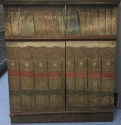








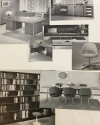
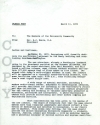
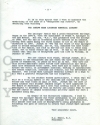













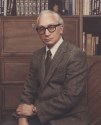


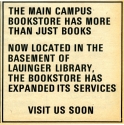








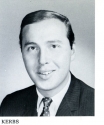

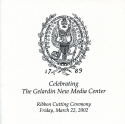
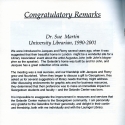
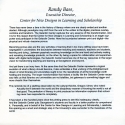
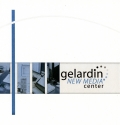
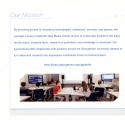

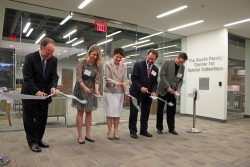

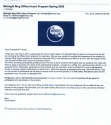










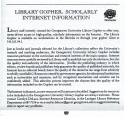






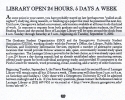

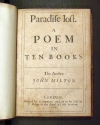












![Conditions Governing Payments to Charitable Institutions. Budget for 1916 As Adopted by the Board of Estimate and Apportionment [The City of New York] Cover of brochure on Conditions Governing Payments to Charitable Institutions. Budget for 1916 As Adopted by the Board of Estimate and Apportionment [The City of New York]](/sites/default/files/x/Conditions%20Governing%20payments_thumb.jpg)

